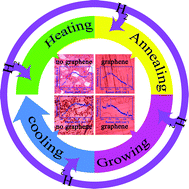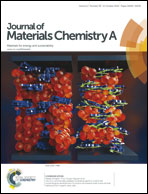Roles of H2 in annealing and growth times of graphene CVD synthesis over copper foil†
Abstract
Single-layer and high-quality graphene was synthesized over Cu foil by atmospheric pressure chemical vapor deposition (CVD) without additionally introducing H2 gas during the growth time. We compared the Cu surface morphology and graphene growth evolution as a function of time, with and without H2 gas supply during the growth time, by AFM, SEM, EBSD, and Raman spectroscopy. The comparison results suggested that the absence of H2 gas supply during the growth time caused the orientated wrinkles, small grain size, more grain boundaries on the Cu surface, as well as high graphene quality and a rapid growth rate. The cross sectional TEM, HR-TEM, and SAED indicated the homogeneity and high quality, which was also confirmed by the low sheet resistance of 710 Ω sq−1. To elucidate the roles of H2 in the annealing and growth times, we introduced H2 at the individual stages of heating, growth, and cooling steps. The data showed that graphene could be grown only when H2 was introduced during the growth time, indicating that the H2 from CH4 pyrolysis was not responsible for graphene growth. Therefore, the existence of H2 during the growth time was essential for graphene growth. This result led us to infer that the H2 introduced during the annealing time could be released from the bulk Cu to promote graphene growth. The release process was further confirmed by the detection of H2 concentrations using a hydrogen analyzer. The results are beneficial to highlight the roles of H2 in the individual reaction steps for the controllable synthesis of graphene.


 Please wait while we load your content...
Please wait while we load your content...